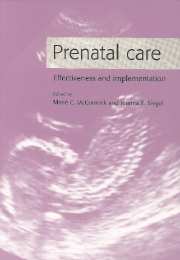Book contents
- Frontmatter
- Contents
- List of contributors
- Foreword
- Acknowledgments
- Introduction
- Part I Prenatal Care and Complications of Pregnancy
- Part II Preventing Prematurity
- Part III New Findings and Long-term Evidence on Intrauterine Growth Restriction
- 6 Causes of intrauterine growth restriction
- 7 Impact of prenatal care on intrauterine growth restriction
- 8 Short- and long-term outcomes of intrauterine growth restriction
- Part IV Preventing and Treating Birth Defects
- Part V Prenatal Care as an Integral Component of Women's Health Care
- Epilogue
- Index
6 - Causes of intrauterine growth restriction
Published online by Cambridge University Press: 17 August 2009
- Frontmatter
- Contents
- List of contributors
- Foreword
- Acknowledgments
- Introduction
- Part I Prenatal Care and Complications of Pregnancy
- Part II Preventing Prematurity
- Part III New Findings and Long-term Evidence on Intrauterine Growth Restriction
- 6 Causes of intrauterine growth restriction
- 7 Impact of prenatal care on intrauterine growth restriction
- 8 Short- and long-term outcomes of intrauterine growth restriction
- Part IV Preventing and Treating Birth Defects
- Part V Prenatal Care as an Integral Component of Women's Health Care
- Epilogue
- Index
Summary
Introduction
Although intrauterine growth restriction (IUGR) has only recently been consistently distinguished from low birth weight (LBW) and prematurity, this distinction has been crucial in our understanding of the causes and consequences of small size at birth and of interventions that might be successful in reducing the incidence and severity of this condition. To provide background information for subsequent chapters, concepts about the etiology of IUGR will be discussed here. The causes of IUGR in diverse circumstances will be presented, along with implications for preventing this condition in American population groups. This chapter focuses primarily on nutritional and behavioral factors, such as smoking, related to IUGR. Other factors related to IUGR are considered in Chapter 7.
Infants who are small at birth also have been described as “small-for-date” or as “small-for-gestational-age.” Most recently, they have been described as having “fetal growth restriction.” In this paper, the term IUGR will be used synonymously with these other terms, although – strictly speaking – this is not correct (Altman and Hytten, 1989).
Definition of intrauterine growth restriction
In classifying infants as having IUGR, we are trying to identify those individuals whose growth, in the simplest terms, is less than their genetic potential. This is not easy to do because it is difficult to know a particular individual's genetic potential for growth.
- Type
- Chapter
- Information
- Prenatal CareEffectiveness and Implementation, pp. 153 - 174Publisher: Cambridge University PressPrint publication year: 1999
- 4
- Cited by



